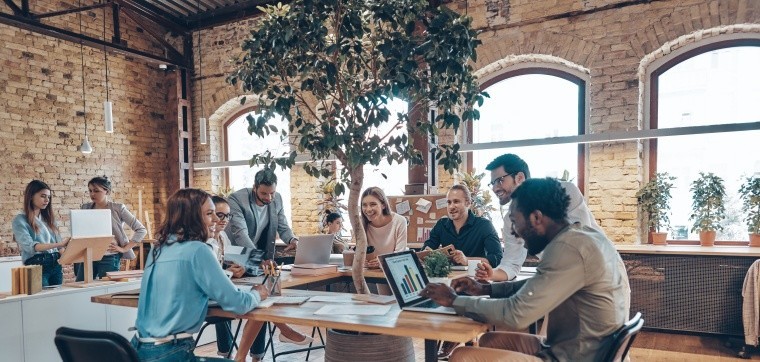The shift towards hybrid work signifies a transformation extending beyond pragmatic considerations such as convenience and cost-effectiveness. Within the dynamic landscape of the labor market, stakeholders venture to re-imagine the very essence of work. This fundamental reassessment of the role of offices is occurring in parallel with a plethora of advancements in technology, equipment, and design. Employees need an empowering environment where they can be productive both as individuals and teams. Learn about the steps to take and the trends to watch out for from the ebook Office of the future by Dell Technologies and prepare your company for the challenges of the future.
Office spaces redesigned to connect people
One of the biggest things that employees want today is a sense of belonging from their work.[1] People expect a place to connect, collaborate and experience their lives holistically from an office space. Traditional, divided offices and cubicles are simply not sufficient anymore. In addition to provide a welcoming environment, companies also need to tackle the challenges coming from outdated hardware that can be expensive to replace. Nevertheless, worker demands, cultural trends, and technology design capabilities make these changes necessary.
Collaboration and interaction
Hybrid and remote work come with asynchronous communication, so the members of the team can maximize their productivity without waiting for others to complete tasks. This trend continues to merge people across geographic and cultural boundaries, to work as a cohesive group. It resulted in the changing role and function of the offices, so when people do come together in person they can make the most out of it.
People first
That’s one of the main reasons that the concept of empathic design is slowly making its way into how offices are designed, putting people first. It’s about creating spaces that are welcoming, reassuring. This can be achieved using biophilic design elements, for example light-filled atriums, rooftop gardens, and living walls.
Office environment that can mirror a harmonious ecosystem, provides an ideal setting for employees to connect. The workplaces of the future will promote organic connectivity, allowing individuals to both chase their professional aspirations and their own sense of purpose. A few key trends in empathic design that are already influencing how people experience and define themselves within the context of work:
- Flexible private spaces mixed with shared can accommodate both introverts and extroverts.
- Dynamic neighborhoods with cafes, co-working spaces, gyms, and gaming spaces fuse work, leisure, and offer more chance for people to connect. The mix of spaces that flow naturally from one to the next, from informal gathering areas to heads-down desks.
- Taking a video first approach equipping just about every space with video conferencing and take a casual collaboration approach to conferencing spaces.
- Offices with good acoustics free of loud echoes allow employees to concentrate better when working alone and feel more connected during collaboration mode.
Sustainability and inclusion
Offices will also need to factor in diversity and inclusion even more and with this comes various communication styles and holidays. When employees come together in the office, it’s crucial that they feel a sense of mutual purpose. Offices need to be about creating memorable moments and connections as well that endure when teams re-disburse to their remote locations.
Additionally, making offices more sustainable can lead to better energy efficiency, reduce costs and help attain sustainable development goals (SDGs). This includes smart investments in areas like lighting, temperature control, and sustainable devices.
Learn more about how the way we work will change the office of the future by downloading the ebook from Dell Technologies here.
Noventiq, as a Dell Titanium Partner, helps you to understand and select the best tools according to needs of your organization. Contact us and let’s create the office of the future at your company.
[1] The New Era of Hybrid Work, Steelcase, Accessed October, 2022.









